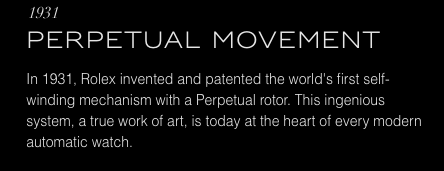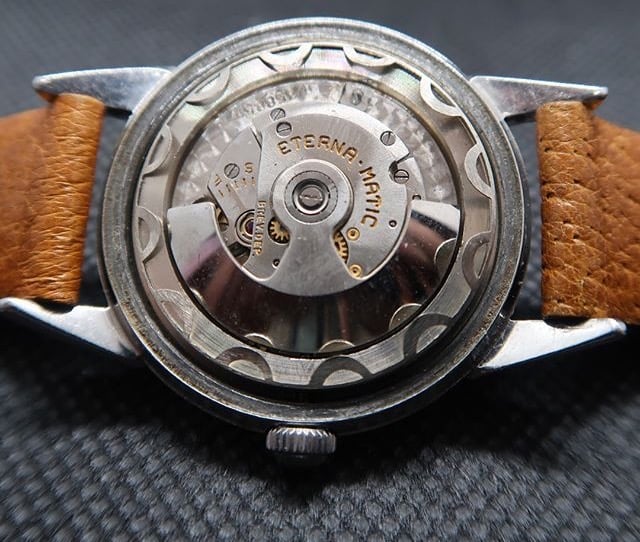- Posts
- 25,980
- Likes
- 27,616
ulackfocus
·There's no doubt that automatic winding units revolutionized the wristwatch. Several inventions, subsequent improvements, and even specific movements have had a vast influence on the industry. Take a look at the Valjoux 7750 series as a recent example - to say it's ubiquitous is an understatement! Regardless of how many watches are powered by a 7750, it didn't make the list because it didn't break new ground. The top 5 are in chronological order.
Harwood bumper

patented: 1924
This winding system may not have been the most efficient, but it was the first. It spawned similar systems in dozens of brands like Omega, Movado, and JLC. Still used into the 60's (in the JLC Memovox for example), they finally disappeared in the 70's.
Rolex Perpetual

patented: 1933
The list of companies that were influenced by this would be too long to type! It was the first 360˚ rotor wristwatch caliber and spawned a new direction in the industry. Combined with Rolex's trademark water resistant Oyster case, it formed the famous Oyster Perpetual.
IWC Pellaton

patented: 1946 & 1950
Seen as the simplest and most efficient winding system ever created, it is still in use today in the IWC 5000 and 8000 series calibers. While Longines did have a flirtation with a similar design in 1945, they added the Pellaton system to their manual winding 8.68N caliber to create the 19A series in 1952 - a very popular movement with the public. Seiko's Magic Lever winding system was based on the concept of IWC's Pellaton excenter technology. Cyma patented a double excenter winding unit even more efficient than IWC's in the early 50's (click HERE for more information from Dr Ranfft's website).
Eterna ball bearing

patented: 1948
Here's the first major improvement to the 360˚ rotor. It was introduced first into ladies watches, and installed in men's versions in 1950. As soon as other companies could get around patent infringement, they adopted & adapted this mechanism to their automatics. This system is still used by ETA who supplies the majority of the industry with movements.
Buren micro-rotor

patented: 1954
When introduced in 1957 inside their Super Slender series as the caliber 1000 and 1001, it was an immediate hit. There was a big push towards thinner watches in that era and this system met the call. Brands like Hamilton, Bulova, and even IWC licensed Buren's products for use in their own watches. Universal Geneve released a nearly identical movement and subsequently lost a patent infringement case to Buren which led to UG's paying of royalties. The Chronomatic Group* used a Buren micro-rotor caliber to make the first automatic chronograph available to the public in 1969. Many high end manufacturers have micro-rotor calibers today including Patek Philippe and Chopard.
Conspicuously absent from the list (and open for discussion) is the Zenith El Primero. While it was the first integrated self winding chronograph, it shared the spotlight with Seiko's 6139 and the Chronomatic Group's caliber 11 in 1969. It also was a combination of technologies. 36,000 bph calibers had been introduced to the public by Girard Perregaux in 1966 and were sent to the Neuchatel Observatory Chronometer Competition by Longines (the caliber 360) as early as 1959. While the EP is a fantastic movement, it did not change the industry as much as the other 5 on the list IMO. It isn't as influential as the Valjoux 7750 family either.
*The caliber 11 is also a worthy honorable mention since the Chronomatic Group team of Breitling, Hamilton, Buren, Heuer, and Dubois Dépraz was the first to rivet a chronograph module to an existing movement. They used a Buren micro-rotor caliber 1280 because of it's slim profile and piggy backed the Dubois Dépraz module on top - a practice still used today in a wide variety of watches but now usually attached to an ETA movement like the 2824 or 2892.
Thanks to Adam, Tony, Andy, Steve, Chin, and Tim for their help with pictures, suggestions, and data.
Harwood bumper

patented: 1924
This winding system may not have been the most efficient, but it was the first. It spawned similar systems in dozens of brands like Omega, Movado, and JLC. Still used into the 60's (in the JLC Memovox for example), they finally disappeared in the 70's.
Rolex Perpetual

patented: 1933
The list of companies that were influenced by this would be too long to type! It was the first 360˚ rotor wristwatch caliber and spawned a new direction in the industry. Combined with Rolex's trademark water resistant Oyster case, it formed the famous Oyster Perpetual.
IWC Pellaton

patented: 1946 & 1950
Seen as the simplest and most efficient winding system ever created, it is still in use today in the IWC 5000 and 8000 series calibers. While Longines did have a flirtation with a similar design in 1945, they added the Pellaton system to their manual winding 8.68N caliber to create the 19A series in 1952 - a very popular movement with the public. Seiko's Magic Lever winding system was based on the concept of IWC's Pellaton excenter technology. Cyma patented a double excenter winding unit even more efficient than IWC's in the early 50's (click HERE for more information from Dr Ranfft's website).
Eterna ball bearing

patented: 1948
Here's the first major improvement to the 360˚ rotor. It was introduced first into ladies watches, and installed in men's versions in 1950. As soon as other companies could get around patent infringement, they adopted & adapted this mechanism to their automatics. This system is still used by ETA who supplies the majority of the industry with movements.
Buren micro-rotor

patented: 1954
When introduced in 1957 inside their Super Slender series as the caliber 1000 and 1001, it was an immediate hit. There was a big push towards thinner watches in that era and this system met the call. Brands like Hamilton, Bulova, and even IWC licensed Buren's products for use in their own watches. Universal Geneve released a nearly identical movement and subsequently lost a patent infringement case to Buren which led to UG's paying of royalties. The Chronomatic Group* used a Buren micro-rotor caliber to make the first automatic chronograph available to the public in 1969. Many high end manufacturers have micro-rotor calibers today including Patek Philippe and Chopard.
Conspicuously absent from the list (and open for discussion) is the Zenith El Primero. While it was the first integrated self winding chronograph, it shared the spotlight with Seiko's 6139 and the Chronomatic Group's caliber 11 in 1969. It also was a combination of technologies. 36,000 bph calibers had been introduced to the public by Girard Perregaux in 1966 and were sent to the Neuchatel Observatory Chronometer Competition by Longines (the caliber 360) as early as 1959. While the EP is a fantastic movement, it did not change the industry as much as the other 5 on the list IMO. It isn't as influential as the Valjoux 7750 family either.
*The caliber 11 is also a worthy honorable mention since the Chronomatic Group team of Breitling, Hamilton, Buren, Heuer, and Dubois Dépraz was the first to rivet a chronograph module to an existing movement. They used a Buren micro-rotor caliber 1280 because of it's slim profile and piggy backed the Dubois Dépraz module on top - a practice still used today in a wide variety of watches but now usually attached to an ETA movement like the 2824 or 2892.
Thanks to Adam, Tony, Andy, Steve, Chin, and Tim for their help with pictures, suggestions, and data.
Edited:


